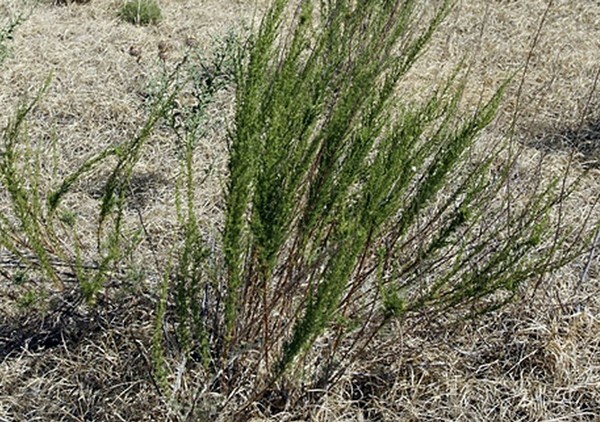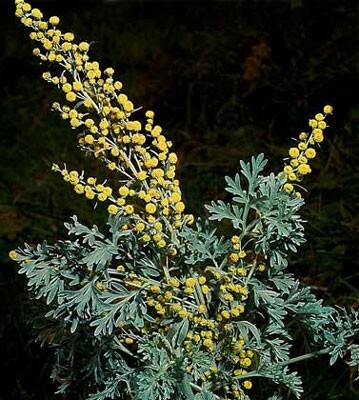- Botanical Description
- Chemical Composition
- Useful Properties
- Procurement of raw materials
- Methods of application
- Precautions
Genus Wormwood Family Complex includes more than 400 plant species, some of which are used in folk medicine for the treatment of various diseases. One of these species is wormwood citrine. This long-term half-shrub refers to endemic plants and in natural conditions occurs only in Central Asia( in the south of Kazakhstan, northern Tajikistan and Uzbekistan), in the valley of the Syr Darya and its right tributary Arys at a height of no more than 370 m above sea level. It is introduced into the culture, plantations for its cultivation on an industrial scale are located in Central Asia. With a curative purpose, only inflorescences with buds or whole grass can be used. Flower baskets of wormwood citrine, called still in the people by the citrated seed, have long been used as an effective remedy for fighting worms, improving metabolism and increasing appetite. The Kazakh name for wormwood is citvar - darma.

Botanical Description
Wormwood cactus grows in dense thickets in river valleys, in desert plains and foothill areas. Prefers loamy carbonate loose soils, it does not tolerate excessive moistening and drying of the soil, it is resistant to frost. Reproduction is carried out by seeds, seedlings and vegetatively dividing perennial roots.
The root is powerful, rod-shaped, with numerous thin lateral roots, deeply penetrates into the soil. The shape is slightly curved, 1.5 - 2 m long, brown in color. From it depart 8 - 20 woody at the base of erect stalks of reddish color. To the upper part the stems become branched. The branches are thin, are at an acute angle to the stem and practically adhere to it. The height of the plant reaches 40 - 70 cm.
The leaf pattern is the next. The leaves are covered with thin hairs, giving them a greyish-green or gray color. The leaves in the lower and upper parts of the plant stem differ in shape and size. The lower ones are on the petioles and have a length of 3 to 6 cm. The leaf plate is twice pinnatally divided into narrow-lobed, at the end blunted lobes. Middle leaves almost sessile, less dissected, upper - sessile, whole, linear and smaller. By the time of flowering, the basal and lower cauline leaves die and fall off.
Interesting: Flowers of wormwood citvarnoy have a peculiar bitter-spicy aroma.

Flowering of wormwood of citric begins in the beginning of September and lasts 10 days. Flowers small in size 2 - 3 mm, bisexual, collected in oblong-ovate sessile baskets, forming narrow, compressed intricate panicles. Each basket contains from 3 to 6 flowers. Corolla yellow or purple, tubular, five-toothed, calyx absent.
Fruits ripen in the second half of October. They are furrowed ovoid achenes of gray color 1.2-1.6 mm long, on one side slightly convex.
Chemical composition of
In the aerial parts of wormwood citric contains:
- sesquiterpene santonin;
- essential oil;
- bitterness;
- organic acids( acetic and malic);
- resins;
- tanning agents;
- minerals( magnesium, calcium, potassium, zinc, copper, etc.).
Sesquiterpene lactone santonin is present in various species of wormwood, but in wormwood its largest quantities are. It is its presence in the plant causes anthelminthic properties. The maximum content of santonine is in the unopened flower baskets( up to 7%).In leaves, buds and stems, it is also present, but in a much smaller quantity( 2%).
The healing properties of essential oil of wormwood citric, known as daraminol. It consists mainly of monocyclic terpen cineol and other terpenic compounds( pinene, terpineol, sesquiartemizol, camphor, carvacrol, etc.).
Important: Earlier, santonine has been widely used in medical practice as an anthelminthic drug in the treatment of ascaridosis, but recently it has been used only in veterinary medicine, since safer means have been developed.
Useful properties of
Undiluted flower baskets and herb wormwood have long been used as anthelmintic against roundworms - pinworms and ascarids. In dried and powdered form, they are consumed together with jam, honey or sugar, or they are prepared on their basis with medicinal decoctions and infusions.
Essential oil of wormwood citvarnoy has antibacterial, anti-inflammatory, analgesic and antiseptic effect. External as an irritant and distracting remedy it is used for rheumatism, muscle pain, neuralgia, lumbago and other diseases.
Sesquiartemisole alcohol, which is part of the essential oil, produces guaiazulene, which has the following curative properties:
- reduces the severity of allergy;
- accelerates tissue regeneration processes;
- destroys bacteria;
- lowers blood pressure;
- exhibits anti-inflammatory effect;
- protects cells from free radicals;
- reduces the secretory activity of the stomach.

Gvayazulen is used in the treatment of rheumatism, eczema, bronchial asthma, x-rays, hyperacid gastritis and other diseases. It is a part of such pharmaceuticals as Pinosol, Romazulan, Pinovitum, Pepsan-R.
Essential oil, extracted from wormwood of citric, has found application in perfumery.
Procurement of raw materials
The preparation of wormwood of citric is produced in August, during this period, in the initial phase of the formation of flower baskets, the plant has the highest amount of santonin. As the flower baskets develop, the concentration of santonin decreases. The production of plant raw materials takes place mainly by mechanical means using special techniques.
The grass is cut with a sickle at a height of 15 cm from the ground to preserve the possibility of self-renewal of the thickets, separate sun-burnt and damaged branches, foreign impurities of other plants. Then it is laid out in a single row in loose piles and dried in the sun for 5 to 8 days. Avoid the rain falling on the spread grass, because in this case it will partially lose its healing properties. After it has dried, it is threshed and sieved first through a rare sieve to separate the large parts of the plant( stems and branches), and then through thicker to remove small parts. The procedure is repeated several times to properly separate the flower baskets. The vegetable material thus prepared is then transferred to the plant for processing into santonin and daraminol. From one hectare of land you can collect about 20 - 50 kg of raw materials.
Finished raw materials are well-dried, separated, very small baskets of yellow-green or brown-green color with a camphor-like aroma. Keep it in a ventilated area, in double tissue bags. In pharmacies, they store in the form packed in cartons or cans in a dry, darkened place for 3 years.
Important: Wormwood creeper gradually reduces its natural reserves due to intensive harvesting and a narrow distribution zone, therefore, for self-collection and procurement of raw materials, it is first necessary to obtain permission from local authorities.
Ways of using
In folk medicine from cucurbit wormwood, decoctions and infusions are prepared for external and internal use or use the already prepared citric seed powder, which can be purchased at a pharmacy.
Infusion of wormwood of the citrated
Dried crushed flowers of the plant( ½ st.l) are poured into 6 liters of boiling water, it is insisted for 2 hours. It is used externally for compresses for pains in the joints and muscles.
Broth for enemas with helminths
To a powder of herb wormwood( 1 tbsp.) Add a glass of boiling water, insist for 6 hours, filter. The entire volume of the solution obtained is made by an enema. The course of treatment once a day 4 - 6 days in a row.
Citrus seed from helminths
In the morning on an empty stomach, eat 1 tsp.citrated seed mixed with honey. They do not eat anything and after 2 hours they take the medicine again and drink some laxative.Infusion of worms with the
Put in a thermos 1 tsp.of the citric seed and add 200 ml of boiling water. Close, insist 1 hour and filter. Drink twice a day in the morning before breakfast and in the evening before going to bed.
Infusion of fast-acting helminths
Mix 30 g of birch buds and 5 g of citrated seed, pour in a mixture of ¼ liter of boiling water. Insist 2 hours, filter and take 30 ml to 5 times a day for half an hour before meals for 5 days.
Precautions
Wormwood citrus refers to poisonous plants, so when using it, it is extremely important to be careful and consult a doctor. Against the background of receiving funds from this plant, a change in color perception is possible. Contraindications to their use are:
- pregnancy;
- breastfeeding;
- liver and kidney disease;
- exacerbation of gastritis and stomach ulcers;
- fever;
- of bowel disease.
In case of an overdose, nausea, vomiting, diarrhea, and abdominal pain are noted.
In case of severe intoxication, a person has convulsions, depression of cardiac activity, loss of consciousness, possibly kidney damage in the form of toxic nephronecrosis. When these symptoms occur, it is necessary to call an ambulance, perform a lavage of the stomach, take a salt laxative and drugs that increase diuresis, to remove the toxin from the body as soon as possible.
Appearance of wormwood:
